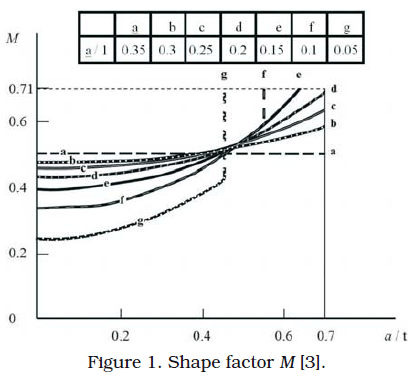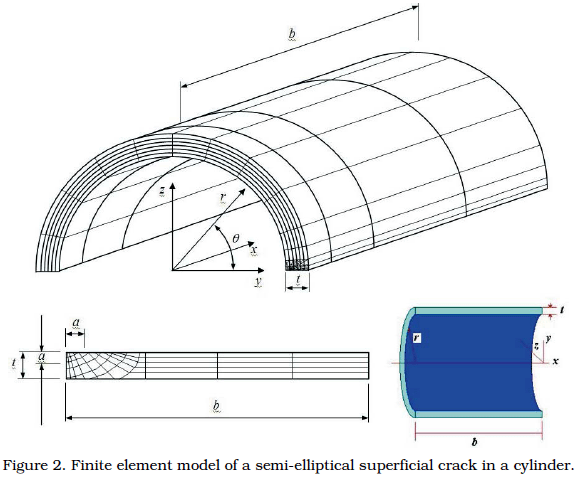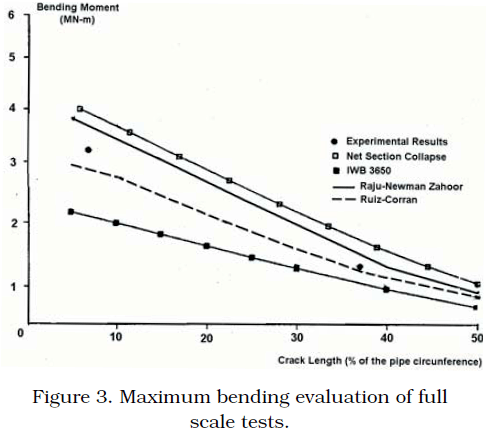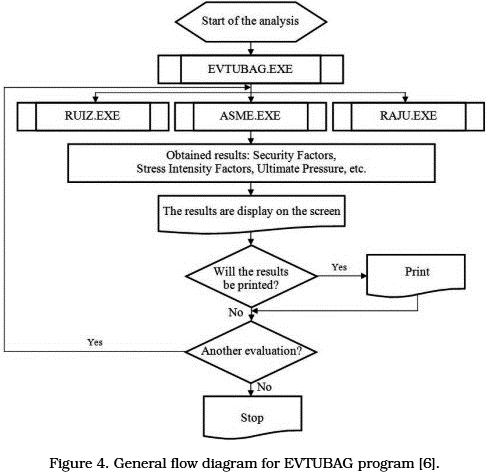Servicios Personalizados
Revista
Articulo
Indicadores
-
 Citado por SciELO
Citado por SciELO -
 Accesos
Accesos
Links relacionados
-
 Similares en
SciELO
Similares en
SciELO
Compartir
Revista Técnica de la Facultad de Ingeniería Universidad del Zulia
versión impresa ISSN 0254-0770
Rev. Téc. Ing. Univ. Zulia v.32 n.3 Maracaibo dic. 2009
Assessment of the structural integrity of cracked cylindrical geometries applying the EVTUBAG program
Luis Héctor Hernández Gómez1, Guilllermo Urriolagoitia Calderón1, Guillermo Urriolagoitia Sosa1, Juan Manuel Sandoval Pineda2, Emmanuel Alejandro Merchán Cruz2 y José Francisco Guardado García1
1Unidad Profesional “Adolfo López Mateos” Zacatenco. Edificio 5, 2do. Piso, Col. Lindavista, C. P. 07738.
2Unidad Azcapotzalco, Av. de las Granjas 682. Col. Santa Catarina, Azcapotzalco, C.P. 02550. Escuela Superior de Ingeniería Mecánica y Eléctrica, Sección de Estudios de Posgrado e Investigación, Instituto Politécnico Nacional. México D.F., México
Abstract
In this paper, the assessment of the structural integrity of pressurized cylindrical components containing defects like cracks was performed, considering two types of failures. Brittle failure was evaluated considering Fracture Mechanics and ductile failure was calculated with a plastic analysis. For this purpose, three methods were used. Accordingly, the program EVTUBAG (evaluation of cracked pipe by its initials in Spanish) was written considering the methodologies proposed by Ruiz and Corran, ASME and Raju-Newman. This paper describes this program and relevant results are discussed.
Key words: Longitudinal cracks, circumferential cracks, stress intensity factor, cracked cylindrical vessel and limit analysis.
Evaluación de la integridad estructural de geometrías cilíndricas agrietadas aplicando el programa EVTUBAG
Resumen
En este trabajo, se realizó una evaluación de la integridad estructural de componentes cilíndricos agrietados sujetos a presión interna. Para este efecto, se consideraron dos tipos de falla. La frágil fue evaluada bajo criterios de Mecánica de la Fractura y la dúctil se calculó con análisis plástico. Para este efecto, se desarrollaron y aplicaron tres diferentes metodologías. Por lo que se implementó el programa EVTUBAG (Evaluación de Tubería Agrietada), en el cual se consideran tres procedimientos, propuestos por Ruiz y Corran, ASME y Raju-Newman. En este artículo se describe la aplicación de este programa y se analizan los resultados relevantes obtenidos.
Palabras clave: Grietas longitudinales, grietas circunferenciales, factor de intensidad de esfuerzos, recipiente cilíndrico agrietado, análisis al límite.
Recibido el 08 de Septiembre de 2008
En forma revisada el 28 de Septiembre de 2009
Introduction
The normal operation and ageing process of materials at industrial installations produce cracks in pressurized cylindrical components. From the structural integrity viewpoint, cracks in pressure vessels and piping systems can be grouped in the following basic cases: (1) axial cracks subjected to internal pressure and (2) circumferential cracks subjected to opening moment and axial loads. Cracks can be through-wall or part through-wall thickness. In first instance, crack initiation is evaluated following the Fracture Mechanic principles due to fracture toughness can be exceeded. While in the second case, a limit analysis is required, when yield stress is reached at the uncracked section. Reliable results are in the open literature and several solutions have been proposed by the use of the Finite Element Method (FEM) [1]. On the other hand, there are some useful solutions which are obtained by the use of explicit expressions [2].
In industrial activities, fast and accurate approaches are needed when there is a cracked cylindrical component. In this case, the operator has to take the decision between: (1) the crack is too big, therefore repair work must be done as soon as possible and (2) this crack is not too big, so the repairing work can be done in the future. This approach is very useful to avoid unnecessary unavailability. Therefore, an evaluation tool is required, in order to make accurate and quick evaluations of these cracked configurations. Accordingly, the program EVTUBAG (evaluation of cracked pipe by its initials in Spanish) can analyze in a simplified manner the cases mentioned above. Also, the regulatory guidance, which applies to Nuclear Installations, is considered. For this purpose, the methodology proposed by Ruiz and Corran [3], the ASME Code Section XI [4] and the numerical solutions of Raju-Newman [5] were selected.
The reasons why these procedures were considered are the following: Simplified solutions are proposed in [3], by using Fracture Mechanics and Limit Analysis. It was validated with some experimental results reported in the open literature. Regarding the circumferential crack case, ductile failure is evaluated in this paper only for through-wall thickness crack under opening moment and axial loads. Although more loading cases of such methodologies are included in Table 1. They are treated with more detail in [6]. Regarding the ASME Code Section XI [4] procedure, it was considered because this is part of the regulatory guidance that is applied by some nuclear installations. However, ASME Code procedures only evaluate part through-wall cracks. The Raju-Newman [5] solutions are introduced as a benchmark. The proposed methodologies evaluate the structural integrity of a cylindrical vessel under internal pressure.
Scope of EVTUBAG program [6]
|
| Through wall | Part through-wall |
| 1. Longitudinal cracks (Internal pressure) | 1. Ruiz and Corran [3] (Brittle and ductile failure). 2. Raju-Newman (Brittle failure). | 3. Ruiz and Corran [3] (Brittle and ductile failure). 4. ASME (Brittle, elasto-plastic and ductile failure). 5. Raju-Newman (Brittle failure). |
| 2. Circumferential cracks (Opening moment and axial loads) | 1. Ruiz and Corran [3] (Ductile failure). 2. Raju-Newman (Brittle failure). | 3. Ruiz and Corran [3] (Ductile failure). 4. ASME (Brittle, elasto-plastic and ductile failure). 5. Raju-Newman (Brittle failure). |
In the case of a longitudinal through-wall thickness cracks, a geometry correction factor proposed by Folias [7] is considered for the Fracture Mechanics Analysis. In other words, the Stress Intensity Factor (SIF) is:
![]()
where ![]() , sH is the hoop stress, l is the crack length, De is the external diameter and t is the cylinder wall thickness. In the case of a longitudinal part through-wall crack, the following equation is used (M is the shape factor):
, sH is the hoop stress, l is the crack length, De is the external diameter and t is the cylinder wall thickness. In the case of a longitudinal part through-wall crack, the following equation is used (M is the shape factor):
KI = MsH(p l)1/2 (2)
Theoretical Basis of the EVTUBAG Program
Failure analysis proposed by Ruiz and Corran [3]
The shape factor M (obtained in Figure 1) M is function of the crack depth and length. If crack depth is greater than 0.7 of the cylinder thickness, the crack may behave in one of the following two manners. In first instance, the crack has infinite length and depth a. It is supposed that crack propagates through the cylinder thickness. The SIF is calculated by:
![]()
In second instance, the crack length increases and the SIF is:
![]()
Summarizing, the SIF depends on the cracked geometry, the applied stress and crack dimensions. For this reason equations (1), (2), (2a) and (2b) are similar. In the case of the ductile failure, a limit analysis is done considering an adimensional parameter Pl*, which relates the required pressure for the generation of general yield of a cracked pipe with the required pressure for general yield of the same pipe without crack. For a longitudinal crack (equation 3), where sf is flow stress:

In the case of a through wall thickness circumferential crack, Pc*, instead of Pl*.
Two cases are considered. The first one is when the cracked cylinder is under internal pressure, and the following equation is used:

where: s is the longitudinal stress. In the second case, M* is the relation between the ductile failure caused by a bending moment (Mb) of a cracked pipe and the plastic failure bending moment (4sf t r2) of an uncracked pipe ![]() . When this bending moment is parallel to the crack, the required relation is:
. When this bending moment is parallel to the crack, the required relation is:
![]()
Otherwise, when the bending moment is normal to the crack, the following calculation has to be done:
![]()
In other words, M* is a geometrical factor and it depends on the way the bending moment is applied. In the next step of this methodology, a safety factor is obtained for brittle and ductile failure. For a brittle failure in axial cracks:
![]()
where KIC is a critical Stress Intensity Factor of the material. For a longitudinal crack, a brittle failure occurs when the SF is equal or less than one. In the case of ductile failure of longitudinal cracks, a similar safety factor is evaluated:
![]()
If the SFDuctile is equal or lower than one, failure occurs. In this case, sf is the flow stress, s is the design stress and Pl* is a relation between the fluency pressure of the uncracked pipe and the fluency pressure of the cracked pipe. In order to know the behaviour of the cracked component, the safety factors are compared. In the case of circumferential cracks, the safety factor is calculated with the following relation. In this case a longitudinal stress is generated and it may be considered as the resultant of an axial load. When ductile failure occurs, the following evaluation is carried on.
![]()
and when there is a bending moment and ductile failure takes place:

Summarizing, equation 7, 8 and 9 evaluate the safety factor related with ductile failure. Their difference depends on crack geometry and loading conditions.
ASME code analysis [4]
Section XI of the ASME Boiler and Pressure Vessel Code establishes the criteria and the requirements for service and pre-service inspection and testing. For class 1 components, the article IWB 3000 of Division I establishes the acceptance standards for cracked vessels, piping, bolting, pumps, etc. If the crack size is greater than those allowed by the table IWB-3410-1, then an analytical evaluation can be followed. In the case of Ferritic steel pipe, the Code Case N463 [8] can be observed when the acceptance standards are exceeded. Alternatively, crack evaluations in Austenitic pipe can be done with the Code Case N-436 [9]. In general terms, the Code Case N-463 has two acceptance criteria. The first one is function of crack size, while the second depends on the applied stresses. Moreover, the failure cases are considered in the evaluation phase, namely (1) limit load failure, (2) elastoplastic fracture mechanics, where ductile crack propagation may occur before reaching the limit load and (3) brittle failure, which is analyzed with elastic Fracture Mechanics. Regarding case N-436, only limit analysis is considered, because austenitic steels have high fracture toughness.
Numerical solutions proposed by RAJU-NEWMAN [5]
Raju and Newman have evaluated numerically the SIF for a wide range of elliptical cracks loaded under Mode I. FEM was used for longitudinally cracked cylinder under internal pressure, when the defect is on the internal or external surface (Figure 2). Furthermore, four stress distributions through the thickness are considered, namely (1) Uniform, (2) Lineal, (3) Quadratic, and (4) Cubic. From all these cases, the influence coefficients, Gj, are obtained for other stress distributions like internal pressure or thermal shock. According to Figure 2, the SIF of an external surface crack, KI along its front is calculated with the following equation:

Internal surface cracks in cylinders under internal pressure are evaluated with the following relation:

where Fi is a correction factor, which in terms of Gj and Lamé equation is:

In the case of external longitudinal cracks, the factor Fi is changed by Fe,
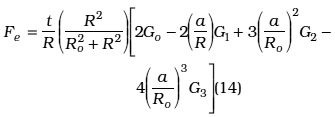
The values are obtained from [5] and they are integrated in EVTUBAG. Summarizing, equations 10 and 12 evaluate the SIF. They depend on crack localization (internal or external surface).
Program Description
EVTUBAG was written in Quick Basic 4.5 and runs in Pentium PC with a 16 MB Ram memory and 540 MB hard disk minimum. This program has four subroutines, Figure 4 shows its flow diagram.
The main one is EVTUBAG, which handles the input data that can be used in the other three subroutines (RUIZ, ASME, RAJU). The subroutine RUIZ follows the procedure described in [3]. The cases which can be analyzed are part through-wall and through wall thickness longitudinal cracks under the scope of brittle and ductile failure. Moreover, the ductile failure of circumferential cracks is covered. For this purpose, axysimetric part through-wall cracks under internal pressure and through wall thickness cracks under internal pressure and/or bending moment may be calculated. The ASME subroutine follows the crack size acceptance procedure proposed in IWB-3514 section XI for nuclear power plant components for two situations: (1) longitudinal cracks under internal pressure and (2) circumferential cracks under internal pressure, bending moment and/or axial loading. It has to keep in mind that the scope of ASME Code only considers the case of part through-wall cracks.
When crack size is bigger than the acceptable standards, ASME subroutine has two calculation procedures. The first one is for austenitic piping (Code Case N-436) [9]. Alternatively, when the analyzed pipe is made by ferritic steel, the Code Case N463 [8] is followed. In the RAJU subroutine, the stress intensity factors are evaluated. Accordingly, part through-wall and through wall thickness longitudinal cracked pipe under internal pressure may be analyzed. Besides, there are two alternatives for the analysis of circumferential cracks. The first one is related with axysimmetric and semi elliptical part through-wall cracks under internal pressure. On the other hand, the second case is related with the through wall thickness cracks under internal pressure, bending moments and/or tensile loading. Each of the subroutine mentioned above may be used independently or linked. This program is complemented with a database, containing tabulated and graphical data of ASME Code or the influence coefficients of Raju-Newman solutions. A detailed description of the complete program can be found in [6].
Validation of the Program
The Mexican Regulatory Body required a program, which evaluates in a short period of time and accurately the structural integrity of cracked cylindrical geometries. Brittle and ductile failure mechanisms have to be considered in such evaluations. In this case, the proposed procedures by ASME, Ruiz and Raju Newman were included. The above mentioned methodologies are widely accepted and they have been validated elsewhere in the past. For the case of this paper, EVTUBAG is validated with the following cases:
Longitudinal crack
CASE I (Longitudinal part through-wall wall crack)
The internal radius and wall thickness of the cylinder analyzed is 2.286 m and 0.2286 m respectively. Crack length is 0.3429 m and its depth is 0.05715 m. Material properties are; Young Modulus is 206.85 GPa, Yield Stress is 413.7 MPa and Poison´s Ratio is 0.3. Two loading cases were considered. In the first case, the internal pressure was 15.6 MPa and in the second case, the internal pressure was 31.16 MPa. The results are shown in Table 2. In this case, brittle fracture was analyzed. For the purpose of validation, it was considered the analysis reported in [10], in which the J-integral value was obtained. In order to make a comparison, the J-values were transformed to the SIF in plane strain conditions. As it can be seen, all the results match.
Comparison of SIF values (Case I)
| Internal Pressure MPa | Values from Reference [9] | Results obtained with EVTUBAG for KI (MPa m1/2) | |||||||
| J (m) | KI (MPa m1/2) | KI / K0 | Ruiz | Raju | ASME | ||||
| KI | KI / K0 | KI | KI / K0 | KI | KI / K0 | ||||
| 15.6 | 3.79 | 77.03 | 1.11 | 74.7 | 1.07 | 75.82 | 1.09 | 79.77 | 1.15 |
| 31.16 | 17.91 | 167.47 | 1.2 | 149.4 | 1.07 | 151.6 | 1.09 | 159.5 | 1.15 |
CASE II (Longitudinal through wall thickness crack)
One brittle failure case was proposed, which was previously solved by the authors with the Finite Element Method using ANSYS 9.0 code. The external diameter and wall thickness are 0.508 m and 0.015 m respectively. Crack length is 0.492 m. Regarding the material properties, Young´s Modulus is 210 GPa and Poisson Ratio is 0.3. As fracture conditions are analyzed, the elastic properties are only required. All the calculations were performed with an internal pressure of 36.7 MPa. In order to make a complete comparison, KI was calculated with other equations which have the following general form ![]() . The main difference is its geometrical factor, which it takes in to account the crack length, a, the vessel radius R, and the vessel wall thickness t. In all cases, the hoop stress was introduced. Results are shown in Table 3. In the evaluation of the results, it is important to keep in mind that the Raju-Newman procedure is based on a FEM analysis. Also, both solutions are in agreement with the one obtained with the geometrical factor reported in [11]. On the other hand, the solution of Ruiz and Corran and the one obtained with the correction factor reported in [12] are similar. All these analyses are appropriate for brittle behaviour and the geometry of the cracked body plays an important role. Therefore, all the solutions may be as a range of solutions.
. The main difference is its geometrical factor, which it takes in to account the crack length, a, the vessel radius R, and the vessel wall thickness t. In all cases, the hoop stress was introduced. Results are shown in Table 3. In the evaluation of the results, it is important to keep in mind that the Raju-Newman procedure is based on a FEM analysis. Also, both solutions are in agreement with the one obtained with the geometrical factor reported in [11]. On the other hand, the solution of Ruiz and Corran and the one obtained with the correction factor reported in [12] are similar. All these analyses are appropriate for brittle behaviour and the geometry of the cracked body plays an important role. Therefore, all the solutions may be as a range of solutions.
Comparison of SIF values obtained by diverse methods (Case II).
| Equation | KI (GPa m1/2) | KI / K0 | Reference |
| |
2.78 | 21.28 | [10] |
| FEM | 2.26 | 17.30 | ANSYS 9.0 |
| |
2.25 | 17.22 | [11] |
| Ruiz | 2.75 | 21.08 | EVTUBAG |
| Raju-Newman | 2.32 | 17.77 | EVTUBAG |
| ASME | EVTUBAG |
Circumferential crack
CASE III (Circumferential through wall thickness crack)
The experimental results obtained in the US Nuclear Regulatory Commission Degraded Piping Program Phase II [13], were considered. In this case, a full scale test of a straight pipe, under bending loading at 288°C, was done. Its external diameter and thickness are 0.7112 m and 0.0236 m respectively. The pipe material was steel A516 Gr 70. One of the objectives was the determination of the maximum allowable bending moment. Therefore, two conditions were analyzed. In the first case, a short circumferential crack was introduced; its length was 6% of the circular perimeter. In a second instance, a long circumferential crack was evaluated. Its length was 37% of the circular perimeter of the pipe. The experimental evidence has shown that circumferential short cracks tend to have a ductile behaviour, while circumferential long cracks tend to have a brittle behaviour (Figure 3). Also, in this figure, the results obtained with the Net Section Collapse (NSC) are plotted. This can be considered as the upper limit of the range of solutions. On the other, the lower limit of the range of solutions is obtained with the IWB 3650 procedure of ASME.
The last two evaluations were done within the full scale test programme mentioned above. The Ruiz and Corran procedure was run for different crack lengths. The results are close to those obtained experimentally. Also, such results tend to be close to those obtained with the IWB 3650. Alternatively, the modified Raju-Newmann results overestimate the failure moment. It is important to keep in mind that the limit load solutions provided by Zahoor [14] were introduced as a complement for the Raju-Newman procedures. These results are close to the NSC solution. In general terms, both procedures give results within the range of solutions described before. The results obtained with the Ruiz and Raju-Newman-Zahoor procedures are shown in Table 4.
Maximum allowed bending moment (Case III)
| Test conditions | Maximun moment applied intests Ratio = ¾¾¾¾¾¾¾¾¾¾¾¾¾¾¾¾¾¾¾ Maximun moment calculated | |||||
| Test | Crack length/pipe circular perimeter l/(pD) | Maximum experimental moment (kN-m) | NSC | IWB 3650 | Ruiz | Raju Newman Zahoor |
| 1.1.1.21 [14] | 0.0625 (short crack) | 3246 | 0.868 | 1.535 | 1.114 | 0.875 |
| 4111-2 [12] | 0.37 (long crack) | 1204 | 0.738 | 1.131 | 0.984 | 0.822 |
They were compared against the experimental results and the evaluations performed with Net Section Collapse (NSC) and IWB 3650 of ASME procedures reported in [13, 15 and 16]. In this case an adimensional comparison is made, the ratio between the maximum moment applied in the experimental tests and the maximum moment calculated with the methods considered. In fact, the solutions which are closed to the unity may be considered as the best. For the case of the short crack (6% of the pipe perimeter), an elastoplastic behaviour was observed. It is important to keep in mind that it is appropriate for the analysis of brittle behaviour. In the case of the long crack, it was also observed an elasto plastic failure. The results obtained with the Ruiz-Corran behaviour were close to the experimental result. The modified Raju-Newmann analysis also gave a result which is close to the experimental failure moment. As it was expected, the NSC and the IWB 3650 evaluate the failure moment, which are in the limits of the range of solutions. In general terms, the evaluations of EVTUBAG are in line with the experimental evaluation.
Conclusions
It was shown in this paper that the program EVTUBAG can perform complete structural integrity assessments on cracked cylindrical components. In this case, it is avoided the use of numerical analysis, such as the Finite Element method, which demands a large amount of computing resources. Besides, this sort of analyses requires a lot of time. All the cases that are presented in this paper were calculated in a short period and they only required a few amount of computing resources. Actually, this program is being used by the Mexican nuclear regulatory body. Another advantage of EVTUBAG program is that diverse methodologies are concentrated in one programme and they can be run together. Furthermore, ductile and brittle failure can be evaluated. In the first case, fracture mechanics concepts are taken into account, while in the second case, the failure is evaluated since the point of view of limit analysis. Therefore, the analyst has a scope of solutions which can be compared among them. The analyst has to keep in mind that during operation, the material properties could be degraded. In consequence, it is important to use in the evaluations the actual properties of the material. The results presented in this paper and other cases that were used to evaluate the performance of the program showed a good convergence with the solutions. Even if EVTUBAG uses simple equations, this fast method has acceptable agreement with the known formal solutions.
Acknowledgements
The authors gratefully acknowledge the financial support granted by de Consejo Nacional de Ciencia y Tecnología and the Instituto Politécnico Nacional. Also, it is in high recognition the support given by Mr. Pablo Ruiz López of the Comisión Nacional de Seguridad Nuclear y Salvaguardas.
Notation
a : Half width
De : External diameter
Gj : Influence coefficients
KI : Stress Intensity Factor (mode I)
KIC : Critical Stress Intensity Factor (mode I)
l : Crack length
M : Shape factor
M*: Adimensional moment parameter
Mb : Bending moment
Pc*: Adimensional pressure parameter, for pipes with circumferential cracks
Pl*: Adimensional pressure parameter, for pipes with longitudinal cracks
Q : Geometrical shape factor
t : Cylinder wall thickness
s : Longitudinal stress
s f : Flow stress
s H : Hoop stress
References
1. Dickson, T. L., Bass, B. R. and Williams, P. T., A comparison of fracture mechanics methodologies for postulated flaws embedded in the wall of nuclear reactor pressure vessel, Pressure Vessel and Piping Design Analysis, ASME Publications PVP-Vol. 430, (2001), 277-284. [ Links ]
2. Wallin, K., Comparison of the scientific basis of Russian and European approaches for evaluating irradiation effects in pressure vessel steels, European Network on Ageing Materials and Evaluation, VTT Manufacturing Technology, Finland, (1994) 1-32. [ Links ]
3. Ruiz, C. and Corran, J.S. Practical application of extremal elastic-ideally plastic solutions for the assessment of the severity of cracks. International Journal of Pressure Vessels and piping, Vol. 10, No 5, (1982), 361-373. [ Links ]
4. American Society of Mechanical Engineers Boiler and Pressure Vessel Code, Section XI, Rules for inservice inspection of nuclear power plant components, Appendix A, Analysis of flaws, Article A-3000, Method for KI determination, American Society of Mechanical Engineers, New York, (1998). [ Links ]
5. Raju, I. S. and Newman, Jr.J.C. Stress intensity factors for internal and external surface cracks in cylindrical vessels. Journal of Pressure Vessel Technology, Vol. 104, No 4, (1982) 293-298. [ Links ]
6. Guardado-García, J. F., Evaluación de la integridad estructural de recipientes cilíndricos agrietados sometidos a presión interna, Tesis de Maestría en Ciencias. Instituto Politécnico Nacional, SEPI-ESIME, (1998). [ Links ]
7. Folias, E. A., In mechanics of fracture, Vol. III, Sih. G. C. (Ed), Noordhoff, 1977. [ Links ]
8. ASME, Cases of ASME Boiler and Pressure Vessel Code, Case N-463: Evaluation Procedures and Acceptance Criteria for Flaws Class 1 Ferritic Piping that Exceed the Acceptance Standards of IWB-3514.2, Section XI, Division 1, ASME, New York, (1988). [ Links ]
9. ASME, Cases of ASME Boiler and Pressure Vessels Code, Case N-436-1: Alternative Methods for Evaluation of Flaws in Austenitic Piping, Section XI, Division 1, ASME, New York, December, (1987). [ Links ]
10. Bloom, J. M. and Lee, D.R. Function solutions for pressurized cylindrical vessels having semi-elliptical surface flaws. Journal of Fatigue and Fracture Mechanics in Pressure Vessels and Piping, Vol. 304 (1995) 105. [ Links ]
11. Ewalds, H, L. and Wanhill, R. J. H., Fractures Mechanics, EAP, (1969) 52-59. [ Links ]
12. Folias, E.S. A finite line crack in a pressurized spherical shell. International Journal of Fracture, Vol. 1, No 1, (1965) 20-46. [ Links ]
13. Wilkowski, G. M. and Sankauskas, G. Degraded piping program-phase II, Summary of technical results and their significance to leak-before-break and in-service flaw acceptance criteria, March 1984-January 1989, Battelle, NUREG/CR-4802. U.S. Nuclear Regulatory Commission, Vol. 8 (1989). [ Links ]
14. Zahoor, A., Ductile fracture handbook; Circumferential throughwall cracks, Vol. 1, EPRI Report NP-6301-D, Electric Power Research Institute, Palo Alto Ca. (1984). [ Links ]
15. Wilkowski, G. M. and Scott, P.M. Short Cracks in Piping Welds, Semi-annual Report, Battelle, NUREG/CR-4599. U.S. Nuclear Regulatory Commission, Vol. 1, No 1, April-September, (1992). [ Links ]
16. Corran, R. S. J., Davies, P H. and Ruiz, C. Engineering of Fracture Mechanics, 16 (1982), pp 585. [ Links ]













